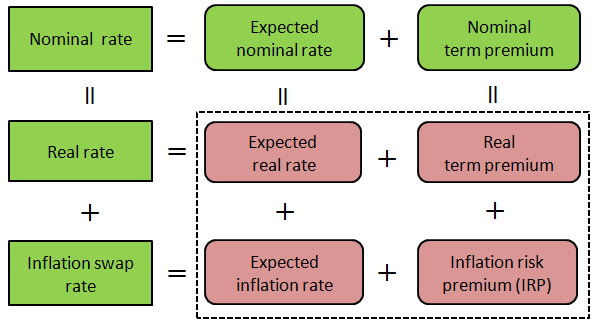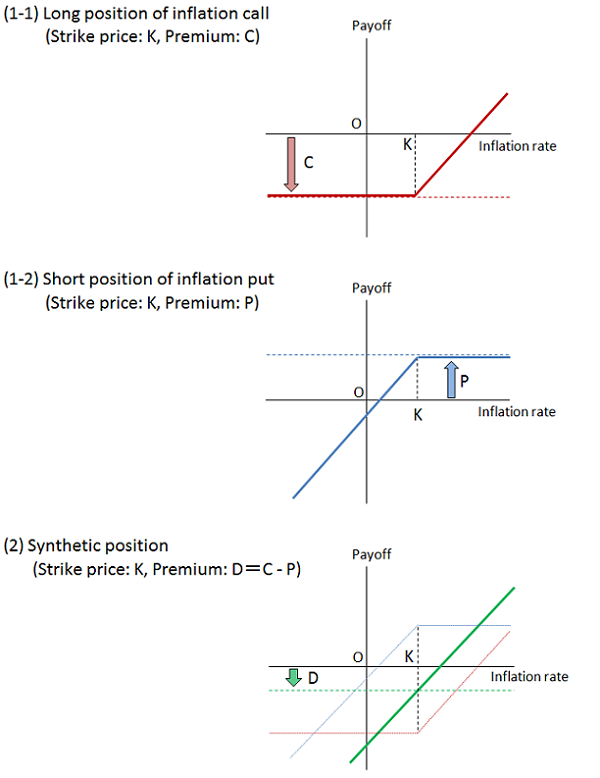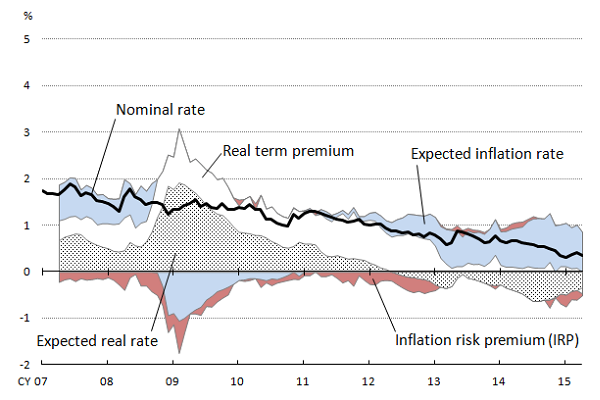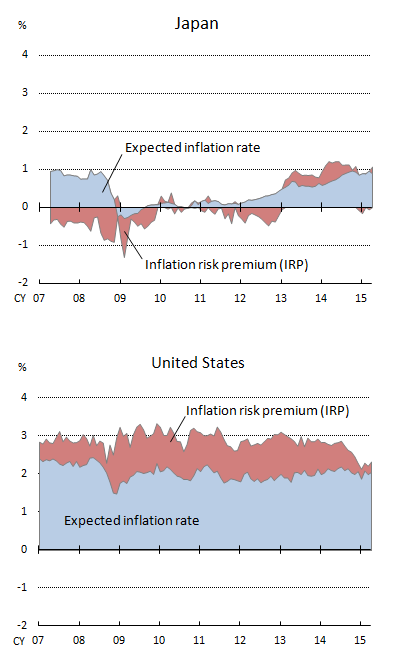What do negative inflation risk premia tell us?
Kei Imakubo, Jouchi Nakajima (Bank of Japan)
Research LAB No.15-E-4, July 9, 2015
Keywords: Inflation risk premia; Term premia; Term structure
JEL Classification: E31, E43, E52, G12
Contact:kei.imakubo@boj.or.jp (Kei Imakubo)
Abstract
The inflation risk premium is an indicator of uncertainty about future inflation. While a positive premium on inflation risk implies more concern about the upside risk of inflation, a negative premium implies more concern about the downside risk. In Japan the inflation risk premium had been constantly negative over a period of time until the end of 2012, but turned positive in early 2013. This finding suggests that market concerns about future inflation have shifted to the upside risk along with a gradual increase in the expected inflation.
Introduction
The inflation risk premium (IRP) is often explained as compensation required by bond holders for bearing inflation risk, which takes a positive value. In fact, however, the IRP takes both positive and negative values. This fact is theoretically clear. The sign of the IRP is known to be determined by a correlation between investors' expected inflation and their intertemporal rate of marginal substitution (Campbell et al., 2009). Concretely, if the correlation is negative, the IRP is positive, and vice versa. Meanwhile, we do not necessarily need such an explanation based on the capital asset pricing model (CAPM) when deriving the sign condition for the IRP; we can derive it from more general assumptions. The purpose of this article is to explain the IRP in a more concise and intuitive manner.
What are inflation risk premia?
The IRP is one of the components of the nominal rate of interest. As illustrated in Figure 1, the nominal rate, which is the yield on fixed-coupon government bonds, can be decomposed into a real rate and an inflation swap rate -- i.e., the yield on inflation-indexed government bonds and the breakeven inflation rate implied by those bonds, respectively. Furthermore, the nominal rate, the real rate, and the inflation swap rate can be decomposed into their respective expectation components and premia. Concretely, the nominal rate is decomposed into the expected nominal rate which represents the expected average future path of the nominal short-term interest rate, and the nominal term premium which reflects uncertainty about the overall interest rate fluctuations. Similarly, the real rate is decomposed into the expected real rate and the real term premium, and the inflation swap rate into the expected inflation and the IRP. In sum, the nominal rate consists of the following four components: expected real rate, real term premium, expected inflation rate, and IRP.
Figure 1. Components of the nominal rate of interest

As illustrated by the payoff diagrams in Figure 2, the IRP, one of the components of the inflation swap rate, corresponds to premia on inflation-indexed interest rate options (inflation options), where a strike price is equal to the expected inflation. Consider a bond holder receiving a fixed coupon and a bond issuer paying it. For the bond holder, if the realized inflation is higher than the expected inflation, his realized real return is lower than the expected one. In this case he can hedge his risk of unexpectedly higher inflation by buying from the bond issuer the inflation call with the strike price equal to the expected inflation, K. Its option premium, denoted by C in the figure, increases as the bond holder is more concerned about the upside risk of inflation. For the bond issuer, she can hedge her risk of unexpectedly lower inflation by buying from the bond holder the inflation put with the strike price equal to the expected inflation, K. Its option premium, denoted by P in the figure, increases as the bond issuer is more concerned about the downside risk of inflation. As shown in the figure, the bond holder's position, which is a synthetic position of the call long and the short put of inflation options, generates the same payoff as a long position of inflation swap, and the difference between the call and put premia, C - P, is equal to the IRP, denoted by D in the figure. This interpretation of IRP solely assumes an arbitrage-free condition and requires neither complete markets nor representative agents as in the CAPM.
Figure 2. Bond holder's payoffs

Note: The expected inflation is assumed to be K. The figure shows the case of C > P.
As is obvious from Figure 2, the IRP takes both positive and negative values depending on which is greater, the call premium or the put premium. Namely, if hedging needs against the upside risk of inflation are higher, i.e., C > P, the IRP is positive. On the contrary, if hedging needs against the downside risk of inflation are higher, i.e., C < P, the IRP is negative. If these needs are balanced, i.e., C = P, the IRP is equal to zero. The IRP therefore reflects whether market concerns about the upside risk of inflation are higher or lower than concerns about the downside risk of inflation.
Inflation risk premia in Japan
The IRP can be extracted from nominal and real yield curves using a term structure model. This article presents estimation results based on Imakubo and Nakajima's (2015)(PDF:610KB) term structure model, which takes account of the zero lower bound constraint of nominal interest rates. Figure 3 shows the estimated components of 10-year nominal rate in Japan. Despite the upward pressure on the nominal rate due to a rise in the expected inflation and IRP, a fall in both the expected real rate and the real term premium has contributed to the stable and low nominal rate since 2013. While the expected real rate is basically influenced by market views on the current and future monetary policy stance, the real term premium generally reflects the real-term interest rate risk as well as various other factors including the central banks' policy actions (Bernanke, 2013). The recent fall in the real components appears to reflect the Bank of Japan's quantitative and qualitative monetary easing (QQE) program, which is in effect present in the interest rate market through both a commitment channel and a term premium channel by purchasing long-term government bonds.
Figure 3. Real and inflation components of the 10-year nominal rate

Note: The direct effects of the consumption tax hikes on the inflation swap rate are eliminated prior to the analysis.
Figure 4 shows the expected inflation and IRP in the form of 5-year-ahead 5-year forward rates (representing the medium- and long-term rates). We can find two remarkable features in the dynamics of inflation expectations in Japan's interest rate market after the Lehman shock. One feature is that the expected inflation remained at zero percent for a period of time. The medium- and long-term expected inflation was roughly at 1 percent before the Lehman shock, but then sharply dropped to around zero percent immediately after the shock and remained at that level for a while. This situation continued until 2012 when the expected inflation gradually started to increase.
Figure 4. 5-year-ahead 5-year forward rates of inflation components

The other feature is that the IRP remained negative over a period of time. In Japan, the medium- and long-term IRP basically remained negative from before the Lehman shock until the end of 2012. The situation up to the end of 2012 suggests that market participants were strongly concerned about unexpectedly lower inflation than the market average of inflation expectations, i.e., the expected inflation of zero percent. In other words, they were concerned about the possibility that they might face negative inflation. In contrast to the negative IRP that Japan experienced, the U.S. IRP was constantly positive in this period. According to Garcia and Werner (2010) and Joyce et al. (2010), the European IRP was also positive.
If so-called "deflationary concerns" can be characterized by not only the expected inflation of zero percent but also the negative IRP, it was 2013 when market concerns about deflation clearly started to fade. While the medium- and long-term expected inflation kept gradually rising, the corresponding IRP, which was negative over a period of time, turned positive. Subsequently, both the rising expected inflation and the positive IRP have continued against the backdrop of the Bank of Japan's "price stability target" -- 2 percent in terms of the year-on-year rate of change in the consumer price index -- and QQE program. Although the expected inflation has not yet reached the price stability target of 2 percent, market concerns about the downside risk of inflation have steadily weakened. Interest rates in Japan seem to have started reflecting the upside risk of inflation as in the U.S. and European economies.
Concluding remarks
To monitor developments in inflation swap rates or breakeven inflation rates, it is important to identify sources of such changes. Either the expected inflation or the IRP can be a source of changes in inflation swap rates. But changes in the expected inflation, which represents the market average of inflation expectations, and changes in the IRP, which reflects uncertainty about future inflation, have different implications. As in the latter half of 2014 when crude oil prices dropped, inflation swap rates can be temporarily volatile because of changes in the IRP, even if the expected inflation is rising as the Bank of Japan pursues the QQE program. Detailed research on how the interest rate is formed in the market can help to provide important insights into the variability and the stability of market inflation expectations.
References
- Bernanke, B. (2013), "Long-term interest rates (Link to an external website)," remarks at the Annual Monetary/Macroeconomics Conference: The Past and Future of Monetary Policy, March 1, 2013.
- Campbell, J., A. Sunderam, and L. Viceira (2009), "Inflation bets or deflation hedges? The changing risks of nominal bonds(PDF:2.45MB) (Link to an external website)" NBER Working Paper, No. 14701.
- Garcia, J. A., and T. Werner (2010), "Inflation risks and inflation risk premia(PDF:1.41MB) (Link to an external website)," European Central Bank Working Paper Series, No. 1162.
- Imakubo, K., and J. Nakajima (2015), "Estimating inflation risk premia from nominal and real yield curves using a shadow-rate model(PDF:610KB)," Bank of Japan Working Paper Series, No. 15-E-1.
- Joyce, M., P. Lildholdt, and S. Sorensen (2010), "Extracting inflation expectations and inflation risk premia from the term structure: A joint model of the UK nominal and real yield curves," Journal of Banking and Finance, 34, pp. 281-294.
Notice
The views expressed herein are those of the authors and do not necessarily reflect those of the Bank of Japan.
